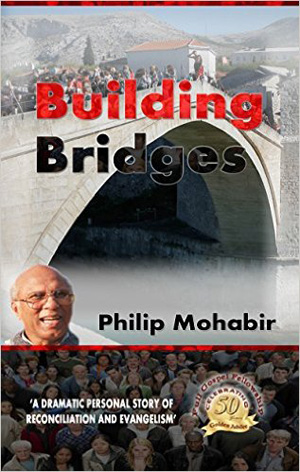by Petamber Persaud
‘Building Bridges’ by Philip Mohabir, Hodder and Stoughton, 1988
A manuscript came to me through the post; its author seeking editorial guidance. On the enveloped were two stamps. One of the stamps, on which this article focuses, is a $160 Guyana stamp released in 2014 to commemorate the Golden Jubilee of the Full Gospel Fellowship of Churches in Guyana. That stamp bears a photograph of the founder of the organization, Philip Mohabir. The Full Gospel Fellowship of Churches in Guyana, responsible for establishing over 150 churches throughout country, started with the vision of that one man who was directed by God to continue his missionary work in strategic areas of Guyana including “Skeldon in the upper Corentyne, Rosehall in the Lower Corentyne, New Amsterdam, Buxton, Georgetown, Leonora/Anna Catherina, Vergenoegen/ Parika, Bartica, Mabaruma, Moruka and some unidentified villages on the East Bank of Demerara.” All of this happened when Mohabir returned to Guyana from Britain in 1964.
The Full Gospel Fellowship of Churches in Guyana, responsible for establishing over 150 churches throughout country, started with the vision of that one man who was directed by God to continue his missionary work in strategic areas of Guyana including “Skeldon in the upper Corentyne, Rosehall in the Lower Corentyne, New Amsterdam, Buxton, Georgetown, Leonora/Anna Catherina, Vergenoegen/ Parika, Bartica, Mabaruma, Moruka and some unidentified villages on the East Bank of Demerara.” All of this happened when Mohabir returned to Guyana from Britain in 1964.
Mohabir’s first missionary calling took him to Britain, arriving in London in April 1956. England was at that time going through the throes of adjustment between Whites and non-Whites. Minority Non-Whites then had little or no voice. But a vexation to Mohabir’s spirit was the division in the church, White Christians and Black Christians not seeing eye to eye on the essential of a religion of which they were followers. There were many reasons for this hostility but not enough to daunt his spirit. In fact, those very reasons drove him to break down racial barriers; barriers that were sometimes branded a sort of apartheid. He used these conditions to create the climate for the founding of unifying forces like West Indian Evangelical Alliance and Connections, which is an inter-denominational, multi-racial Apostolic network of Churches in Britain, other parts of Europe, the Caribbean, Africa and South America.
He spent eight fruitful years in England, a base from which he was able to expand and serve people in distant lands, planting churches. He gained an important foothold in Sweden; one in which he found constant support for his ministry.
In 1964, Mohabir returned to Guyana after it appeared that he had set the stage for unbounded development of the church in the UK. Mohabir returned with part of his team; according to Mohabir it was always teamwork. He and his wife Muriel, good friends, Bryn and his wife, Edna, departed the UK for Guyana as missionaries. Guyana 1964 was a place of racial discord, appearing to be a place with no time to entertain God.
Philip Mohabir was a mighty man of God who broke down many barriers including the racial divide between Christians in the church of Guyana and Whites and non-Whites Christian in the church of Britain.
God was his mainstay but as he admitted in his autobiography he owed a debt of gratitude to numerous individuals and families. One of those persons worthy of mention was his wife, a Jamaican, who acted as a sort of passport to predominantly African Villages. They were confronted with armed mobs but they forged on, winning out in the end, winning over to God the very people who wanted to harm them.
In Guyana, he set up base in Stanleytown, West Bank Demerara, later moving to Walterloo and Murray (now Quamina) streets, in the city of Georgetown, needing more space and a central area from which to groom spiritual leaders for the expanding ministry. Then 242 South Road was acquired. But his work in Guyana was not finish. He conquered the jungle in order to create a cooperative village, Hauraruni, along the Linden-Soesdyke Highway, a safe haven for Christians to worship, to find meaningful employment and to produce spiritual leaders. This wonderful sanctuary is the result of faith in God and hard pioneering work.
Philip Mohabir was born into a Hindu home in 1937. His grandfather came from Gorakhpur, India, bringing his religious books and culture. So it wasn’t easy for Mohabir to declare his conversion to Christianity which happened while he was attending Wray’s High School in Croal Street where he was doing the subject Religious Education just to obtain his matriculation. His text was The Life of Christ and the Bible verses that changed his life were Mark 1: 14 – 19, summed up in Jesus’ call, “Come ye after me, and I will make you to become fishers of men.” From that moment, there was no turning back.
His friend David Tomlinson in the Preface wrote, “I’d be very surprised if this book doesn’t change peoples’ lives. It’s a powerful story with a challenge to everyone who recognizes that God does impossible things through ordinary people who dare to trust him and be courageous.”
He built bridges as reflected in his autobiography Building Bridges. This book tells part of the story – the start of his missionary work in Britain, his return to Guyana, and closes with his trip back to Britain. Building Bridges is a story of tolerance, determination, sacrifice and total reliance on God.
(Responses to this author telephone 592-226-0065 or email: oraltradition2002@yahoo.com)




.png)









